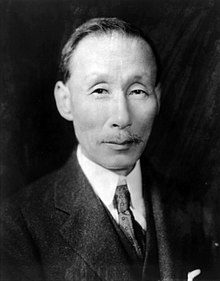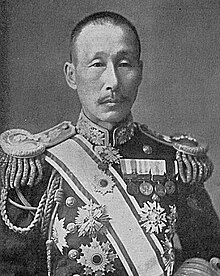| This article needs additional citations for verification. Please help improve this article by adding citations to reliable sources. Unsourced material may be challenged and removed. Find sources: "Katō Tomosaburō" – news · newspapers · books · scholar · JSTOR (January 2025) (Learn how and when to remove this message) |
| Senior Second Rank Marshal-Admiral ViscountKatō Tomosaburō | |
|---|---|
| 加藤 友三郎 | |
 | |
| Prime Minister of Japan | |
| In office 12 June 1922 – 24 August 1923 | |
| Monarch | Taishō |
| Regent | Hirohito |
| Preceded by | Takahashi Korekiyo |
| Succeeded by | Uchida Kosai (Acting) |
| Minister of the Navy | |
| In office 10 August 1915 – 15 May 1923 | |
| Preceded by | Yashiro Rokuro |
| Succeeded by | Takeshi Takarabe |
| Personal details | |
| Born | (1861-02-22)22 February 1861 Hiroshima Domain, Aki Province, Japan |
| Died | 24 August 1923(1923-08-24) (aged 62) Tokyo, Japan |
| Cause of death | Colon cancer |
| Resting place | Aoyama Cemetery, Tokyo |
| Political party | Independent |
| Spouse | Katō Kiyoko (1874–1940) |
| Alma mater | Imperial Japanese Naval Academy |
| Awards | Order of the Chrysanthemum (Grand Cordon) |
| Signature |  |
| Military service | |
| Allegiance | |
| Branch/service | |
| Years of service | 1873–1923 |
| Rank | |
| Commands | Tsukushi, Naval Affairs Bureau, Kure Naval District, 1st Fleet |
| Battles/wars | |
Marshal-Admiral Viscount Katō Tomosaburō (加藤 友三郎, 22 February 1861 – 24 August 1923) was a career officer in the Imperial Japanese Navy, cabinet minister, and Prime Minister of Japan from 1922 to 1923.
Biography

Born in Hiroshima, Aki Province (modern Hiroshima Prefecture) to a samurai family, Katō enrolled in the 7th class Imperial Japanese Naval Academy and graduated second out of a class of 30 cadets. He specialized in both naval artillery and in navigation.
Naval career

After his commissioning as lieutenant, Katō served on the corvette Tsukuba in 1887, followed by the cruiser Takachiho. During the First Sino-Japanese War, he served in a combat position as gunnery officer on the cruiser Yoshino. After the end of the war, he served in numerous staff positions before promotion to commander. He was executive officer on the battleship Yashima, and captain of the Tsukushi. He was promoted to rear admiral on 1 September 1904.
During the Russo-Japanese War, Katō served as chief of staff to Admiral Tōgō Heihachirō on the battleship Mikasa, assisting in Japan's victory at the Battle of Tsushima. During this time, he suffered from a very weak stomach, and was vomiting as he issued orders throughout the battle, despite having taken large amounts of medication.
Katō became Vice Minister of the Navy in 1906, and was promoted to vice admiral on 28 August 1908. In 1909, he was appointed commander of the Kure Naval District, and in 1913 became Commander in Chief of the Combined Fleet.
Katō became Minister of the Navy in August 1915, days before his promotion to full admiral on 28 August 1915. He served in this post in the cabinets of Ōkuma Shigenobu, Terauchi Masatake, Hara Takashi, and Takahashi Korekiyo. Under Hara and Takahashi, Katō was Japan's chief commissioner plenipotentiary to the Washington Naval Conference, and worked with Ambassador Shidehara Kijurō in the negotiations that led to the Five-Power Treaty.
As Prime Minister
Following his return to Japan, Katō was appointed 21st Prime Minister of Japan in recognition of his performance at the Washington Naval Conference. His cabinet consisted mainly of bureaucrats and members of the House of Peers, which proved unpopular with the Imperial Japanese Army. During his tenure as prime minister, Katō implemented the provisions of the Washington Naval Agreement, withdrew Japanese forces from Shandong in China and ended Japanese participation in the Siberian Intervention.
Death
Katō succumbed to late-stage colon cancer and died a little over a year into his term.
Katō was given the honorary rank of Marshal Admiral the day before his death, and posthumously awarded the Grand Cordon of the Supreme Order of the Chrysanthemum and his title raised to shishaku (viscount).
His death came only a week before the Great Kantō earthquake of 1923, and therefore Japan was without a prime minister during that disaster.
Katō's grave is at Aoyama Cemetery, Tokyo.
Honors
From the corresponding article in the Japanese Misplaced Pages
- Order of the Golden Kite, 2nd class (1 April 1906; Fifth Class: 27 September 1895)
- Grand Cordon of the Order of the Sacred Treasure (28 November 1913; Second Class: 30 November 1905; Fifth Class: 9 May 1899; Sixth Class: 24 November 1894)
- Grand Cordon of the Order of the Rising Sun (14 July 1916; Second Class: 1 April 1906; Sixth Class: 27 September 1895)
- Baron (7 September 1920)
- Grand Cordon of the Order of the Paulownia Flowers (7 September 1920)
- Grand Cordon of the Order of the Chrysanthemum (24 August 1923; posthumous)
- Viscount (24 August 1923; posthumous)
References
Books
- Agawa, Hiroyuki (2000). The Reluctant Admiral: Yamamoto and the Imperial. Kodansha International. ISBN 978-4-7700-2539-5.
- Dupuy, Trevor N. (1992). Encyclopedia of Military Biography. I B Tauris & Co Ltd. ISBN 978-1-85043-569-3.
External links
- Nishida, Hiroshi. "Kato Tomosaburo". Imperial Japanese Navy. Retrieved 17 August 2022.
- Newspaper clippings about Katō Tomosaburō in the 20th Century Press Archives of the ZBW
Notes
- Nishida, Imperial Japanese Navy
| Military offices | ||
|---|---|---|
| Fleet created | 2nd Fleet Chief-of-staff 28 December 1903 - 12 January 1905 |
Succeeded byKōichi Fujii |
| Preceded byShimamura Hayao | Combined Fleet & 1st Fleet Chief-of-staff 12 January 1905 - 20 December 1905 |
Combined Fleet Fleet dissolved; post next held by: Yamashita Gentarō |
| 1st Fleet Kōichi Fujii | ||
| Political offices | ||
| Preceded bySaitō Makoto | Vice-Minister of the Navy 8 January 1906 – 1 December 1909 |
Succeeded byTakarabe Takeshi |
| Military offices | ||
| Preceded byYamanouchi Masuji | Kure Naval District Commander-in-chief 1 December 1909 - 1 December 1913 |
Succeeded byMatsumoto Kazu |
| Preceded byDewa Shigetō | 1st Fleet Commander-in-chief 1 December 1913 – 10 August 1915 |
Succeeded byKōichi Fujii |
| Political offices | ||
| Preceded byYashiro Rokurō | Minister of the Navy 8 October 1915 – 15 May 1923 |
Succeeded byTakarabe Takeshi |
| Preceded byTakahashi Korekiyo | Prime Minister 16 June 1922 – 24 August 1923 |
Succeeded byYamamoto Gonnohyōe |
| Prime ministers of Japan (list) | |||||||
|---|---|---|---|---|---|---|---|
| Empire of Japan (1868–1947) |
| ||||||
| State of Japan (1947–present) |
| ||||||
| Imperial Japanese Navy | |
|---|---|
- 1861 births
- 1923 deaths
- 20th-century prime ministers of Japan
- People from Naka, Hiroshima
- Deaths from colorectal cancer in Japan
- Imperial Japanese Navy marshal admirals
- Ministers of the Imperial Japanese Navy
- Kazoku
- People of Meiji-era Japan
- Japanese military personnel of the First Sino-Japanese War
- Japanese military personnel of the Russo-Japanese War
- Recipients of the Order of the Golden Kite
- Recipients of the Order of the Rising Sun
- Recipients of the Order of the Sacred Treasure
- Military personnel from Hiroshima
- Imperial Japanese Naval Academy alumni
- Burials at Aoyama Cemetery